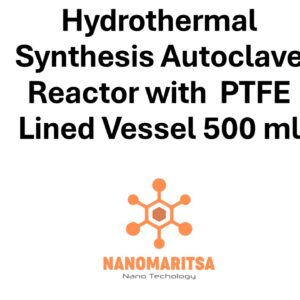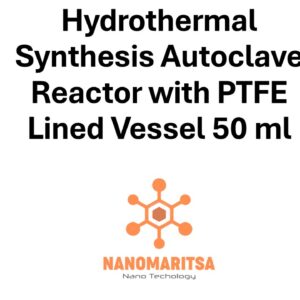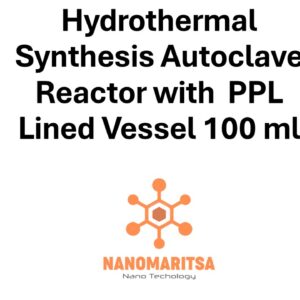PPL Inside Chamber for Hydrothermal Synthesis Autoclave Reactors, Volume:500ml
€480.00
ComparePPL Inside Chamber for Hydrothermal Synthesis Autoclave Reactors (500 ml) is a chamber designed for high-pressure and high-temperature hydrothermal synthesis reactions, featuring an inner lining made of Polyphenylene Sulfide (PPL). PPL is a high-performance polymer that offers excellent chemical and thermal stability, making it an ideal material for maintaining the integrity of the reactor under extreme conditions. This chamber is used in laboratory settings for the synthesis of advanced materials such as nanomaterials, crystals, and catalysts. Here’s a detailed overview:
1. Key Features:
- PPL Lining: The chamber is lined with Polyphenylene Sulfide (PPL), which provides resistance to a wide range of chemicals, acids, bases, and solvents. This ensures that the chamber will not contaminate the materials inside, allowing for pure synthesis of the desired products.
- Volume (500 ml): The chamber has a 500 milliliter (ml) capacity, which is ideal for large-scale experiments or when a higher volume of material needs to be synthesized. This larger volume allows for more reagents and a greater quantity of synthesized material, making it suitable for more extensive research or small-scale production.
- High-Pressure and High-Temperature Resistance: The PPL chamber can withstand high pressures (up to 200-300 bar) and temperatures (150°C to 250°C), which are necessary for hydrothermal synthesis reactions. These conditions help promote the formation of nanomaterials, crystals, and other compounds that require controlled environments.
- Sealed Environment: The chamber is fully sealed within the reactor to maintain a consistent environment, ensuring that the pressure and temperature conditions are stable throughout the synthesis process.
2. Properties:
- Chemical Resistance: The PPL lining provides exceptional resistance to a variety of chemicals, ensuring that the chamber does not react with or alter the substances inside. This is crucial for maintaining the purity and integrity of the synthesized materials.
- Thermal Stability: PPL is highly thermally stable and can withstand high temperatures, typically up to 250°C, without degradation. This allows for the high-temperature conditions required in hydrothermal reactions.
- Mechanical Strength: The PPL material offers high mechanical strength, ensuring that the chamber remains structurally sound under the elevated pressure conditions typical of hydrothermal reactions.
- Non-reactivity: PPL is non-reactive with most chemicals, which ensures that it does not interfere with the reactions taking place inside the chamber, preserving the desired chemical and physical properties of the synthesized products.
3. Applications:
- Nanomaterial Synthesis: The chamber is widely used in the synthesis of nanoparticles, nanowires, and other nanostructures. The controlled high-pressure and high-temperature conditions facilitate the formation of nanomaterials with specific properties, such as high surface area or tunable electronic characteristics.
- Crystal Growth: Hydrothermal synthesis is a common method for growing high-quality crystals, including metal oxides, semiconductors, and other inorganic compounds. The 500 ml chamber is ideal for larger-scale crystal growth, where a higher volume of material is required.
- Catalyst Synthesis: The chamber is also used for the synthesis of new catalysts or for modifying existing catalysts. Hydrothermal conditions promote the formation of catalysts with improved performance for chemical reactions.
- Energy Materials: It is used to synthesize materials for energy storage, such as electrodes for batteries and supercapacitors, as well as for fuel cells. These materials often require precise control over their microstructure, which the chamber’s environment provides.
- Environmental Applications: The chamber can be utilized for creating materials for environmental applications, such as catalysts for air or water purification, and advanced materials for waste treatment and recycling.
4. Handling and Safety:
- Toxicity and Corrosiveness: Although the PPL lining protects the chamber from most chemicals, the substances inside can still be hazardous or toxic. Proper safety precautions must be followed when handling these chemicals to avoid exposure to harmful substances.
- Pressure and Temperature Safety: The chamber operates under high-pressure and high-temperature conditions, so it is essential to ensure that the reactor is functioning properly. Safety protocols must be strictly adhered to in order to prevent accidents, such as leaks or pressure failure.
- Storage: After use, the PPL chamber should be cleaned thoroughly to remove any residual chemicals. It should be stored in a safe, dry, and cool environment to preserve its durability and functionality.
- Precautions: Always wear appropriate personal protective equipment (PPE), such as gloves, goggles, and lab coats, when handling the reactor. It is important to use the reactor in a well-ventilated area or under a fume hood to minimize exposure to hazardous fumes or vapors.
Summary:
The PPL Inside Chamber for Hydrothermal Synthesis Autoclave Reactors (500 ml) is a versatile and durable chamber designed to withstand the extreme conditions required for hydrothermal synthesis reactions. Its PPL lining ensures high chemical resistance, thermal stability, and mechanical strength, making it ideal for the synthesis of a variety of materials, including nanomaterials, crystals, and catalysts. With a larger volume of 500 ml, it is suitable for larger-scale experiments or the production of more material, making it a valuable tool for research and material development. Whether used for nanomaterial synthesis, energy applications, or environmental solutions, the PPL-lined chamber provides a reliable and efficient environment for high-performance hydrothermal reactions.
| Pieces | 1 Piece, 5 Pieces |
|---|






